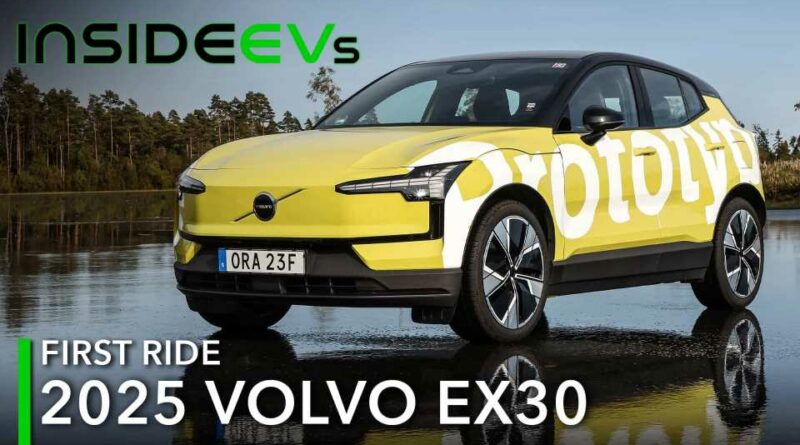2025 Volvo EX30 First Ride Review: Little EV Goes Big On Charm
– Gothenburg, Sweden
“Every Volvo must be predictable, controllable, and comfortable.” That’s the directive from Egbert Bakker, Volvo’s head of vehicle dynamics, who’s driving me around the company’s proving grounds in a super cute Moss Yellow EX30 prototype. It’ll still be a few weeks before I can get behind the wheel of Volvo’s new li’l electric nugget myself. But riding shotgun with Bakker, I’m already finding plenty to like.
When it goes on sale next year, the 2025 EX30 will be Volvo’s smallest, least-expensive model. At 166.7 inches long, 72.3 inches wide, and 61.1 inches tall, the electric EX30 is about the same size as a Hyundai Kona. And with an expected starting price of $36,145 including an $1,195 destination charge, the EX30 will undercut the price of Volvo’s current entry-level EV, the XC40 Recharge, by a full $18,600.
| Quick Specs | 2025 Volvo EX30 |
| Motor | Dual Permanent-Magnet Synchronous |
| Output | 422 Horsepower / 400 Pound-Feet |
| Range | 265 Miles (est.) |
| Charge Type | 153 Kilowatts DC |
| Base Price | $34,950 + $1,195 Destination |
| One-Sale Date | Summer 2024 |
Predictable
None of the EX30’s specs are especially remarkable, yet it’s nevertheless poised to be competitive against other small EVs. In the US, we’ll only get the larger 69.0-kilowatt-hour battery option – 64.0 kWh of which is usable – with a maximum DC fast-charge rate of 153.0 kW. Other countries will be privy to a smaller, 51.0-kWh battery (49.0 kWh usable), with a slower, 134.0-kW charging speed. Volvo has no plans to bring the smaller battery to the US at this time.
On the subject of charging, Volvo will soon adopt Tesla’s North American Charging Standard plug, but the first round of EX30s won’t have this setup. Early customers will get an adapter allowing them to use Tesla’s Supercharger network, but 2026 model year EX30s will be the first ones to have Volvo’s new combo design.
The 69.0-kWh car will come in two straightforwardly named trims: Single Motor Extended Range and Twin Motor Performance. The former has a single electric motor mounted on the rear axle, making 268 horsepower and 253 pound-feet of torque. The latter – unsurprisingly – adds a second e-motor to the front axle, upping output to 422 hp and 400 lb-ft.
Final range numbers are still TBD, but Volvo estimates 275 miles for the single-motor EX30 and 265 miles for the dual-motor version. The aforementioned and similarly sized Hyundai Kona, for comparison, is expected to return 260 miles on a full charge. In the luxury space, the stodgy little Audi Q4 E-Tron achieves 265 miles on a full charge, so the EX30 is right on target – assuming the final EPA ratings hold up.
Controllable
Located outside of Gothenburg, Sweden, Volvo’s Hällered test track is a narrow, winding course with various potholes, undulations, and other suspension-upsetters designed to mimic the conditions of roads around the world. Driving an EX30 Twin Motor Performance, Bakker intentionally points the EV’s nose at these rougher patches, and executes a few sharp steering maneuvers to demonstrate the crossover’s stability at speed. At all times, the EX30 keeps its balance and composure, with appropriate amounts of lateral roll following Bakker’s more aggressive saws of the steering wheel. The EX30 is planted and feels solid, with fewer body motions than Volvo’s higher-riding C40 and XC40 EVs.
We’ll get 19- and 20-inch wheel options in the US, and the Moss Yellow test car rides on the latter, wrapped in European-spec summer tires. The ride is definitely on the firm side, and driving over manhole covers and rough surfaces upsets the EX30 a bit. US-spec cars will have all-season tires, however, so maybe this EV will be a little more compliant when it arrives Stateside. I’m willing to bet the smaller-diameter 19-inch wheels will help some, too, though man, those 20s sure look snazzy.
The EX30 is planted and feels solid, with fewer body motions than Volvo’s higher-riding C40 and XC40 EVs.
Bidding Bakker adieu, I hop into a gray EX30 prototype with the EX30 product lead, Joakim Hermansson. Here, the focus is less on ride and handling and more on the EX30’s power, which is a really pleasant surprise. No, 422 hp and 400 lb-ft aren’t rocket-ship numbers for an electric car these days, but the result is a subcompact crossover that can accelerate to 60 mph in 3.4 seconds, making this Volvo’s quickest production car – ever.
The EX30’s Twin Motor driveline is a variable all-wheel-drive system, where the front axle only comes alive under hard acceleration or when there’s a loss of traction. There’s a Performance AWD drive setting where you can lock the Twin Motor EX30 into permanent all-wheel drive, but there’s a big caveat with this mode: you lose the ability to one-pedal drive. Hermansson said this is due to the different throttle mapping requirements of the standard and Performance AWD modes, and that one-pedal regenerative braking would be way too jerky under the latter setting. Bummer? Sure. Controllable? You bet.
Comfortable
Despite its small size, the EX30 is pretty spacious inside – at least, from the front seats, where there’s no lack of head- or legroom. A lot of the cabin’s open, airy feeling comes down to its great overall design. “Everything has a function” inside a Volvo, Hermansson said, and the EX30 is “one of our most brilliant examples of this.”
Beyond the general aesthetic, the EX30 showcases Volvo’s focus on using textiles that are both sustainable and interesting to look at and touch. Dan Fidgett, Volvo’s head of color and materials, said Volvo really wants to explore “other expressions of Scandinavian premium,” which is why you’ll see things like recycled denim trim, weaves made from plant stalks, wool fabric, and a composite “celestial” deco made from ground-down pieces of recycled scraps. Four “room” themes will be available at launch, all of which look fantastic.
“I think we’re more proud of this than any other car as a design team,” Fidgett said.
The EX30 isn’t perfect, however. There are two window switches on the center console, which isn’t a problem per se, but to control the back windows, you have to press a front/rear toggle, just like the lousy one in the Volkswagen ID.4. The reliance on a single central touchscreen for the majority of all vehicle functions also leaves a lot to be desired, though Volvo maintains things like wiper controls and mirror adjustments will always be physical controls. Maybe this stuff won’t be so bad from behind the wheel. We’ll see.
But Wait, There’s More
Later next year, Volvo will introduce an EX30 Cross Country, with more ground clearance and 18-inch wheels wrapped in 225/55 all-terrain tires. Purposeful cladding and skid plates really work on the EX30, turning this electric crossover into a baby-butch allroader. How this updo will affect performance and range is still under wraps for now.
Cross Country or not, I’m pretty stinkin’ stoked about the EX30 as a whole. And while Volvo is hoping the EX30 will attract lots of new buyers to the brand, brand loyalists should find a lot to like. The EX30 looks to be another predictable, controllable, comfortable Volvo – with an added burst of personality.
Competitor Reviews
- Audi Q4 E-Tron: Not Rated
- Genesis GV60: 9.3 / 10
- Mercedes-Benz EQB: Not Rated
- Tesla Model Y: Rated
FAQs
Will The Volvo EX30 Be Available In The United States?
Yes, the Volvo EX30 will be available in the US. Pre-orders begin in 2024 and Volvo will begin deliveries of its small electric SUV later in 2024.
How Much Does The Volvo EX30 Cost?
The Volvo EX30 starts at $36,145 with the $1,195 destination fee included. More details regarding options and trim levels will be available closer to an on-sale date.
Is The Volvo EX30 Smaller Than The XC40?
Yes, the EX30 is the smallest SUV that Volvo offers and has a 104.3-inch wheelbase. It is also more affordable than the XC40.
Gallery: 2025 Volvo EX30 First Ride Review
2025 Volvo EX30
Source: Read Full Article



